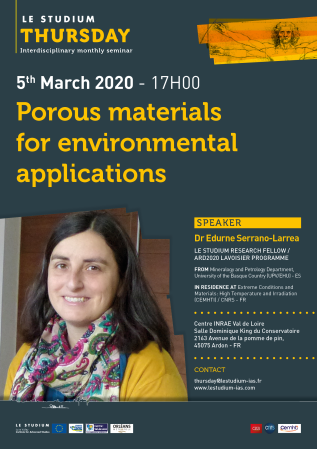Porous materials for environmental applications
Centre INRAE Val de Loire, Salle Dominique King du Conservatoire
2163 Avenue de la pomme de pin
45075 Ardon
France
Presentation
A porous material is a solid containing pores or voids. There are natural porous materials, soils, zeolites, wood…, and many synthetic porous materials. The porosity increases the specific surface area of the porous material, which means that in a small amount of material a big surface could be available for the interaction with external substances. Therefore, they have many applications: filtration, sensing, adsorption, separation, catalysis…
Many efforts have been made to design new porous materials with desirable pore sizes and chemical nature for specific applications. One kind of porous materials whose develop has experienced a great impulse in the last decades are metal-organic frameworks (MOFs). These materials, with ordered extended nets, have regular pores with sizes in the micropore range, suitable to interact with many molecules and substances. The pore walls of these materials can be tuned with diverse chemical functionalities for different applications. Therefore, they have been used to remove very different types of pollutants from water, such as dyes, metals and large molecules.
Other well-known class of porous materials is the activated carbons. These materials are typically derived from natural carbon sources and present high porosity. They have been used for centuries in chemical processes, as well as, for water treatment. Carbons are especially interesting because they are metal-free materials and are able to catalyze several chemical reactions related with the obtaining of green energy vectors, which, currently, are being carried out at large-scale with scarce noble metals. Carbon materials can also be semiconductors, which, added to their porosity, makes them suitable for catalyzing light-aided reactions, such as the solar reduction of CO2 to form added-value products.
Speaker
Dr Edurne Serrano-Larrea,
LE STUDIUM RESEARCH FELLOW / ARD 2020 - LAVOISIER Programme
FROM: Mineralogy and Petrology Department, UPV/EHU - ES
IN RESIDENCE AT: Extreme Conditions and Materials: High Temperature and Irradiation (CEMHTI) / CNRS - FR








